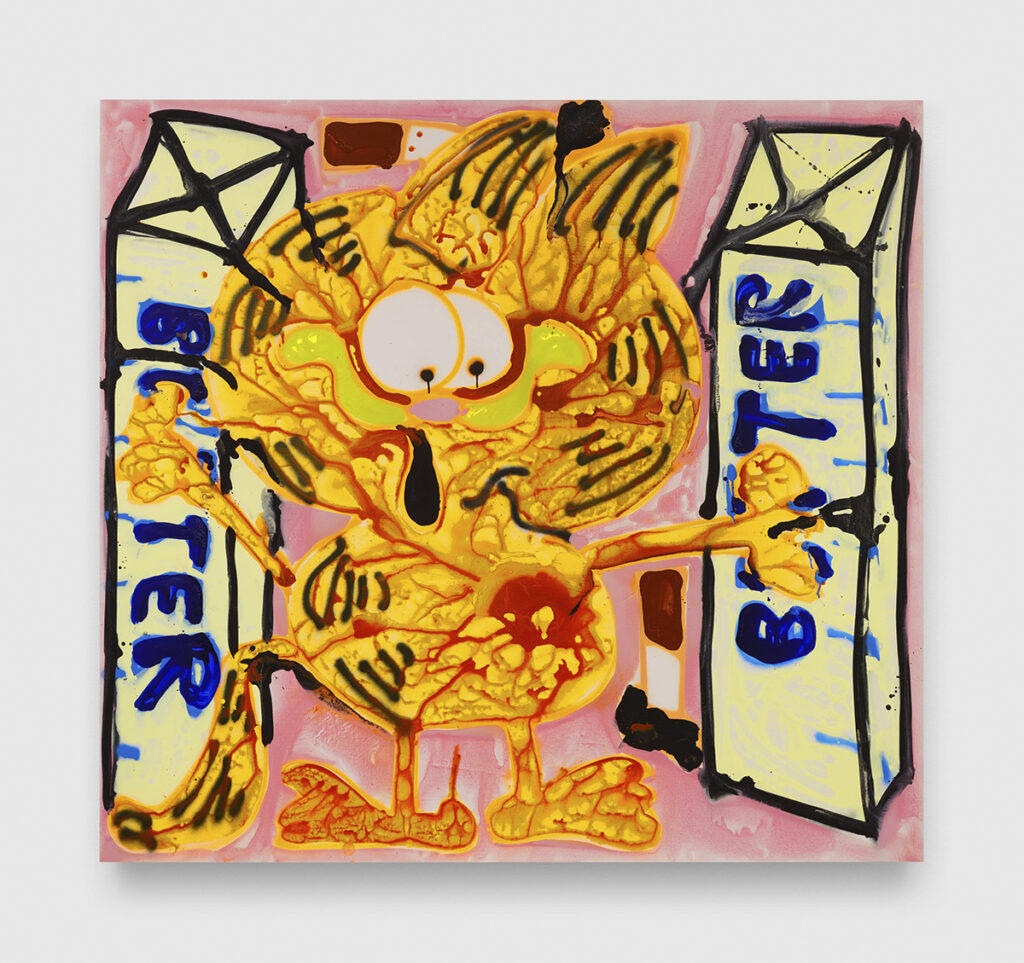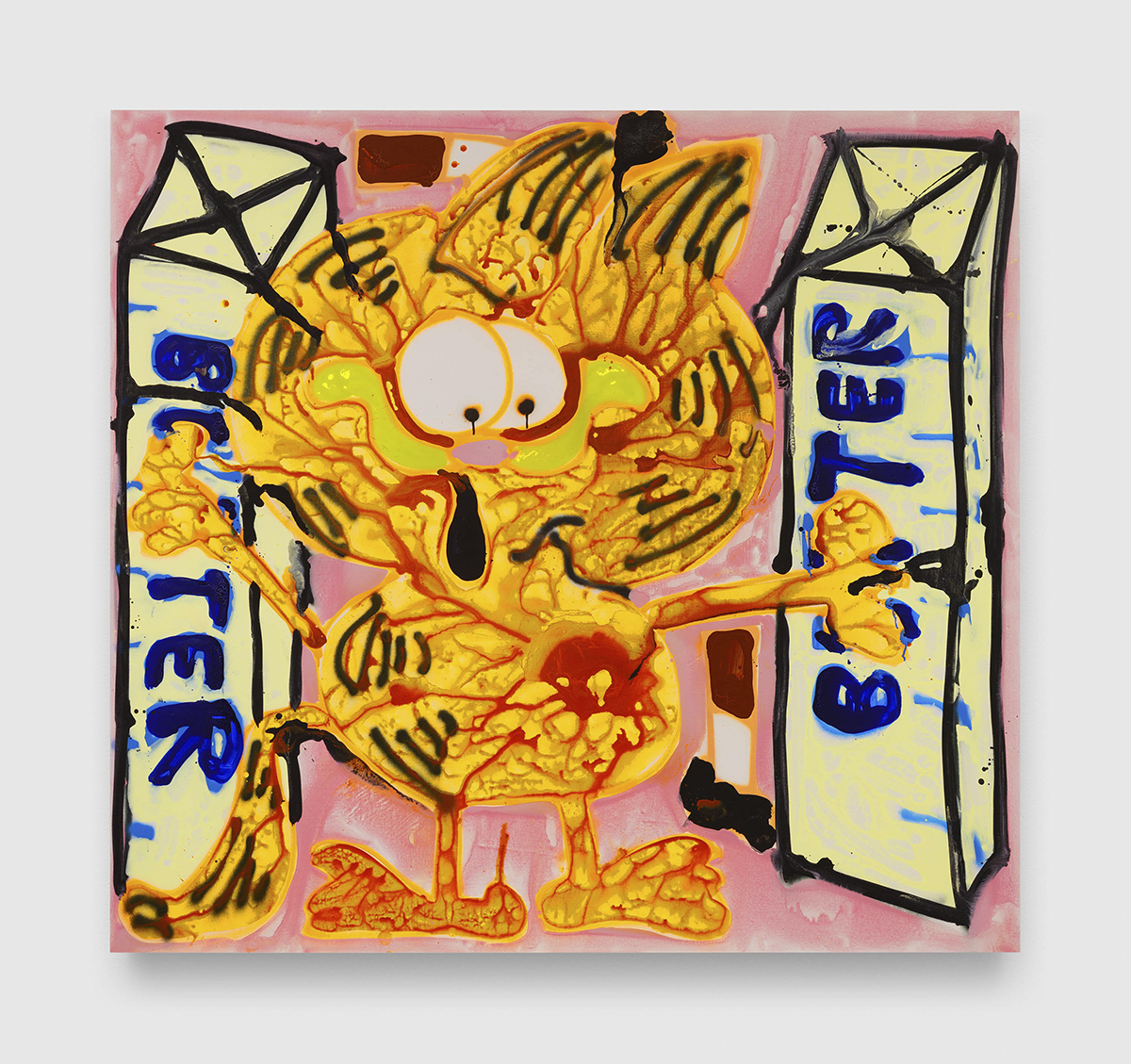
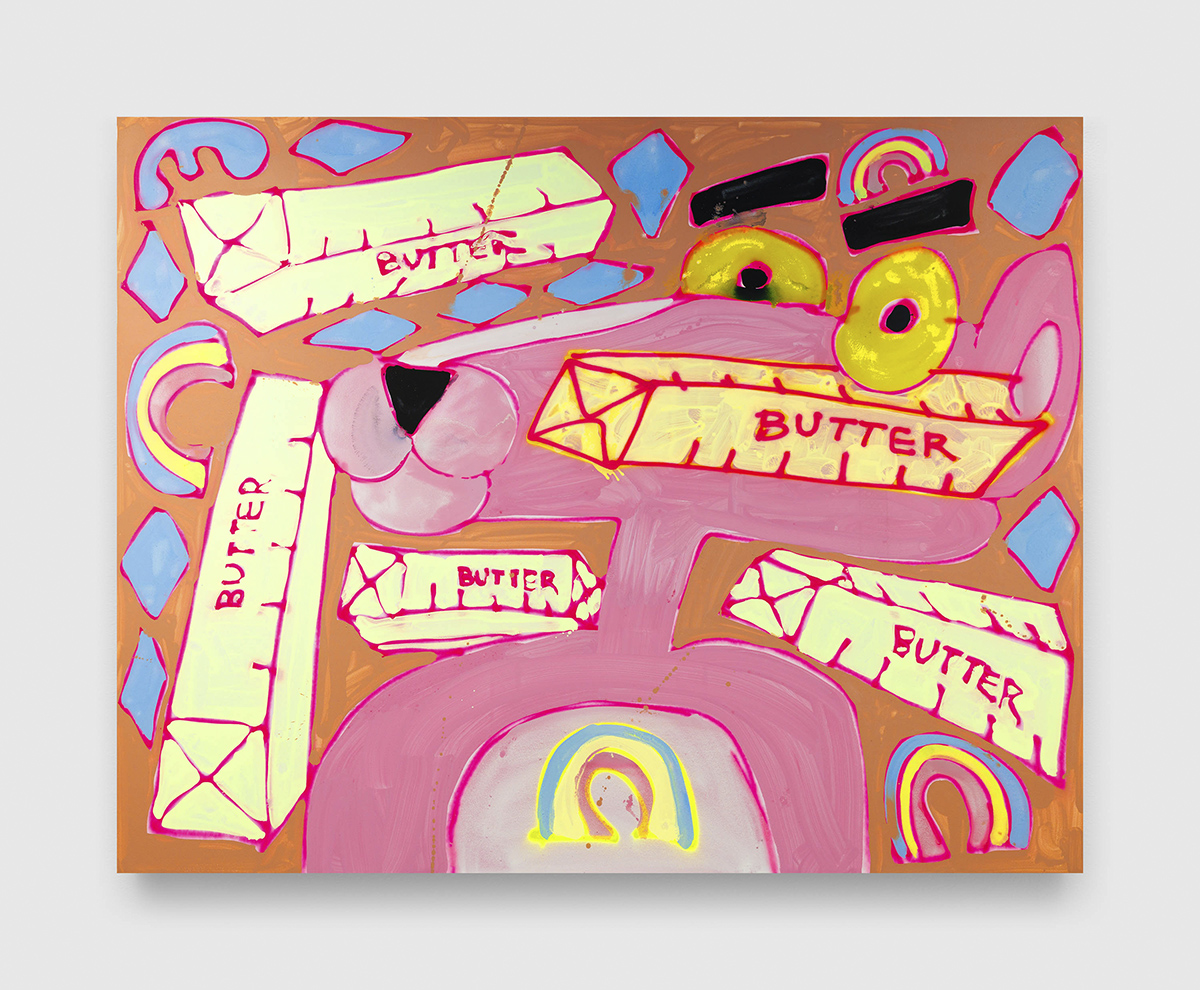
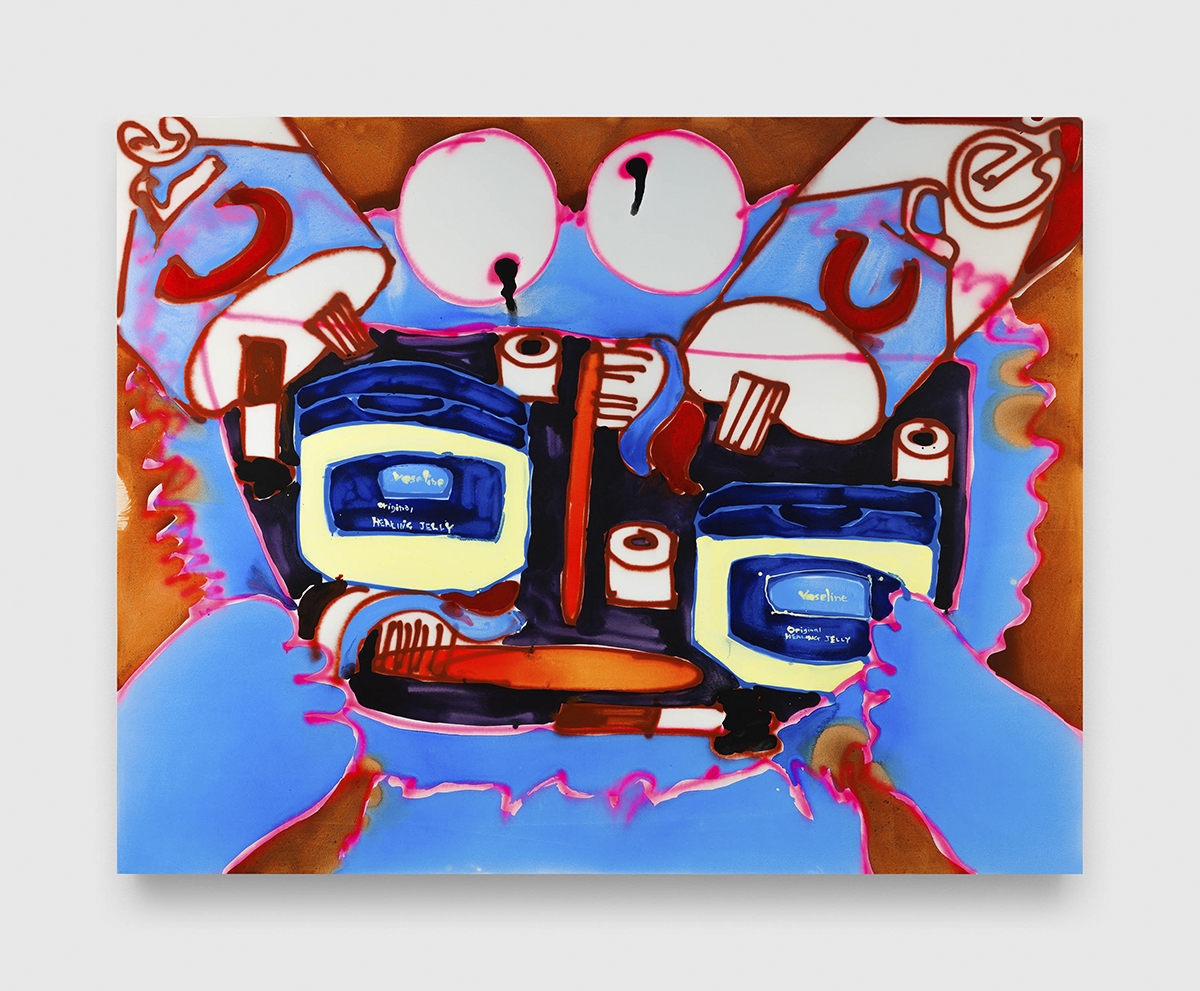


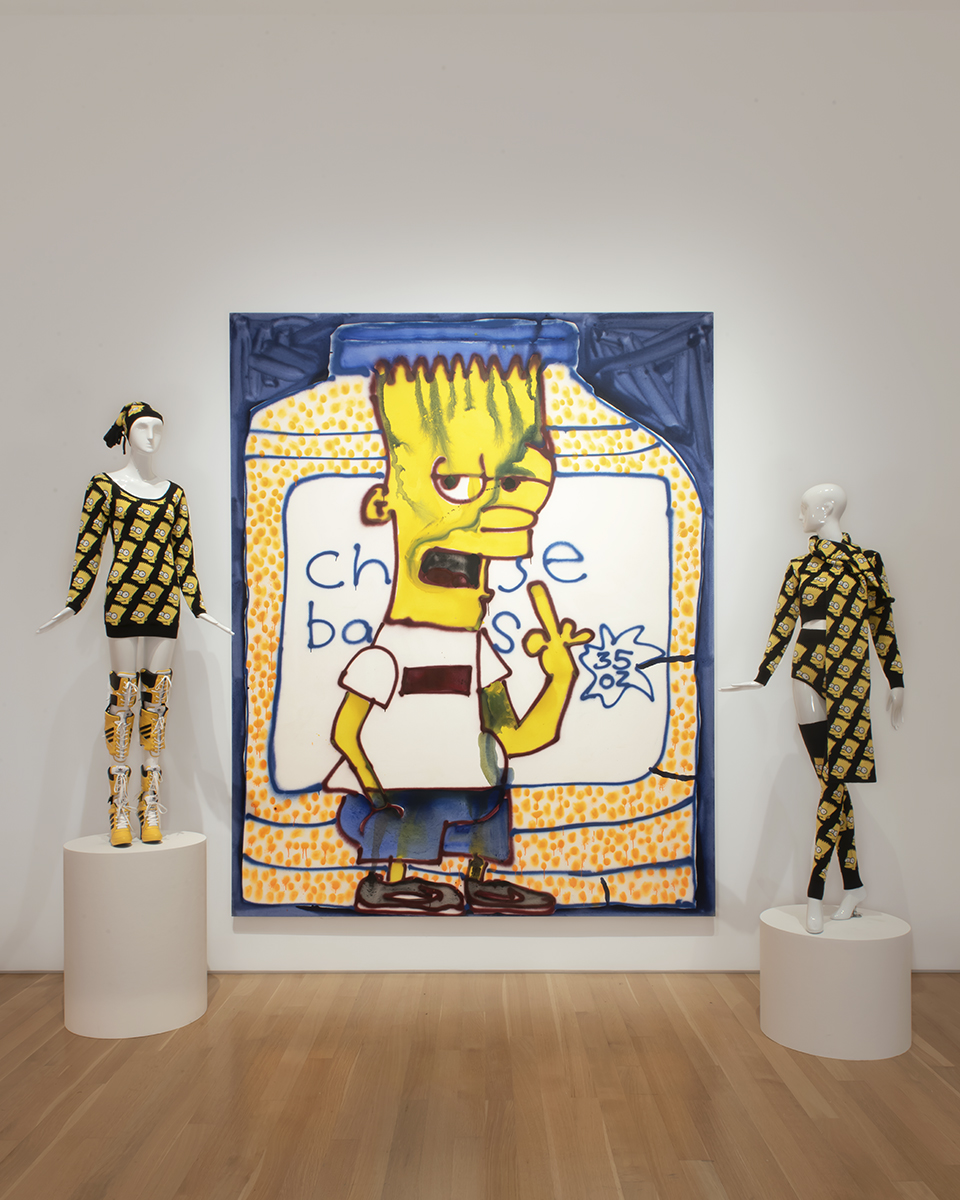
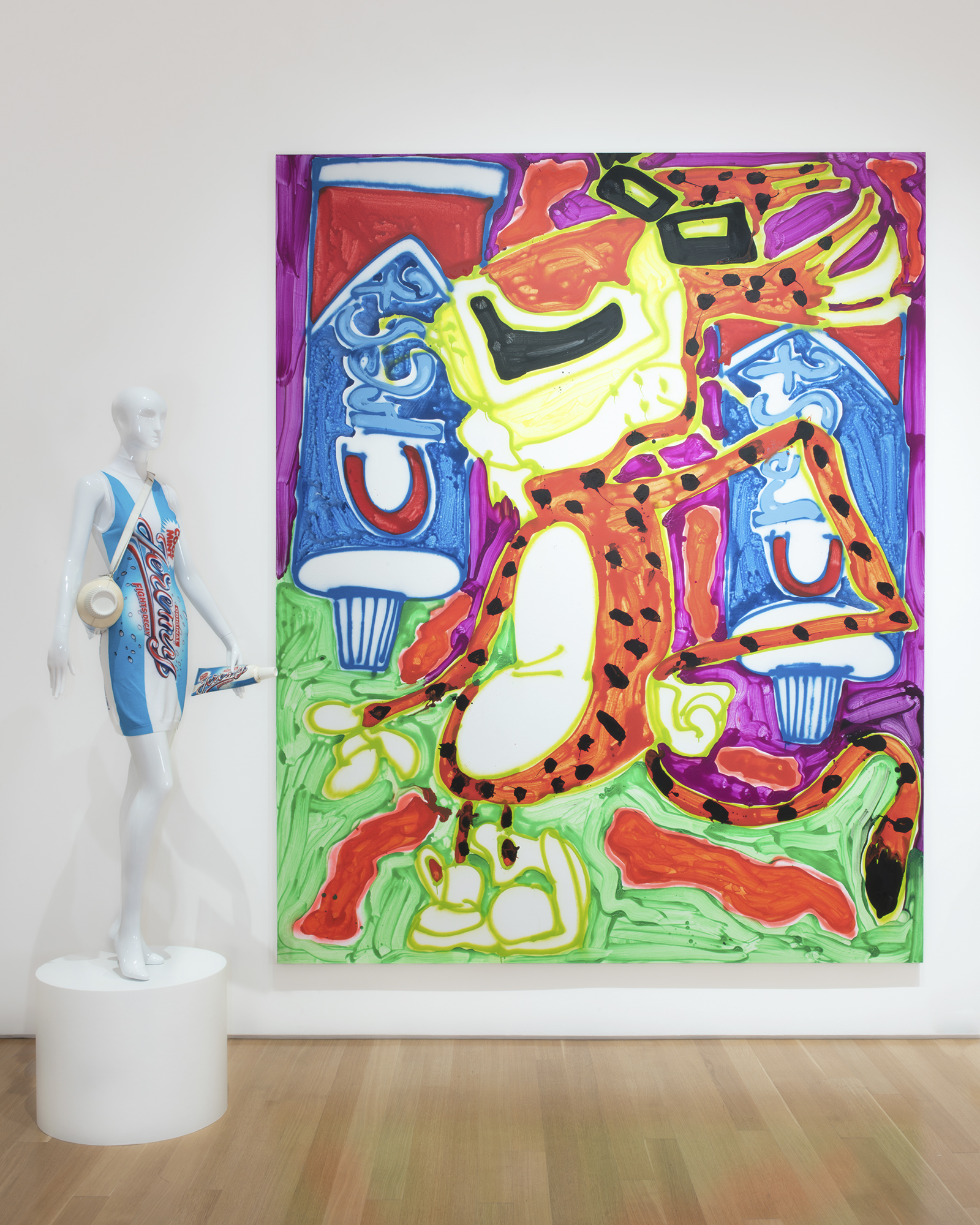
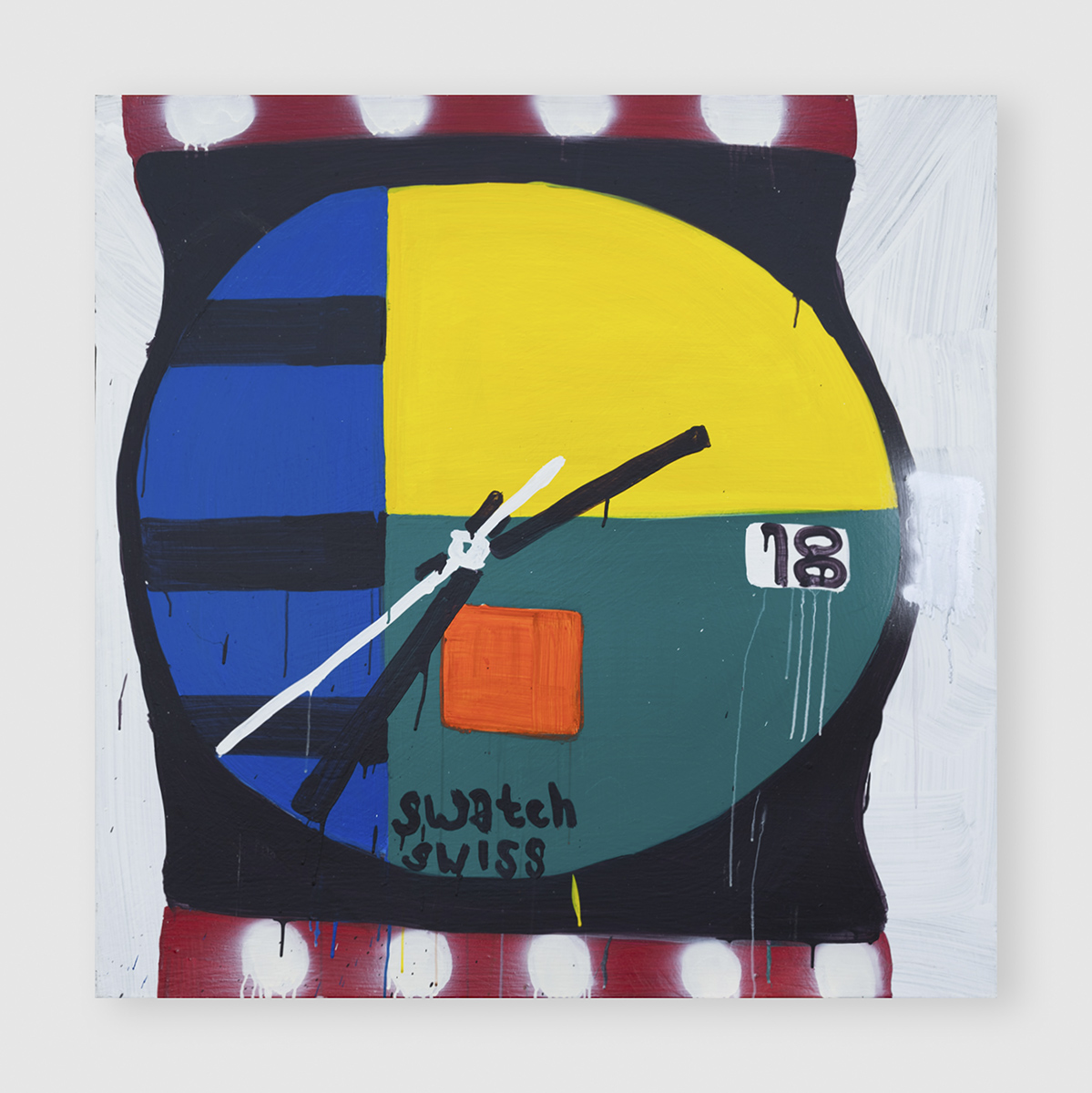
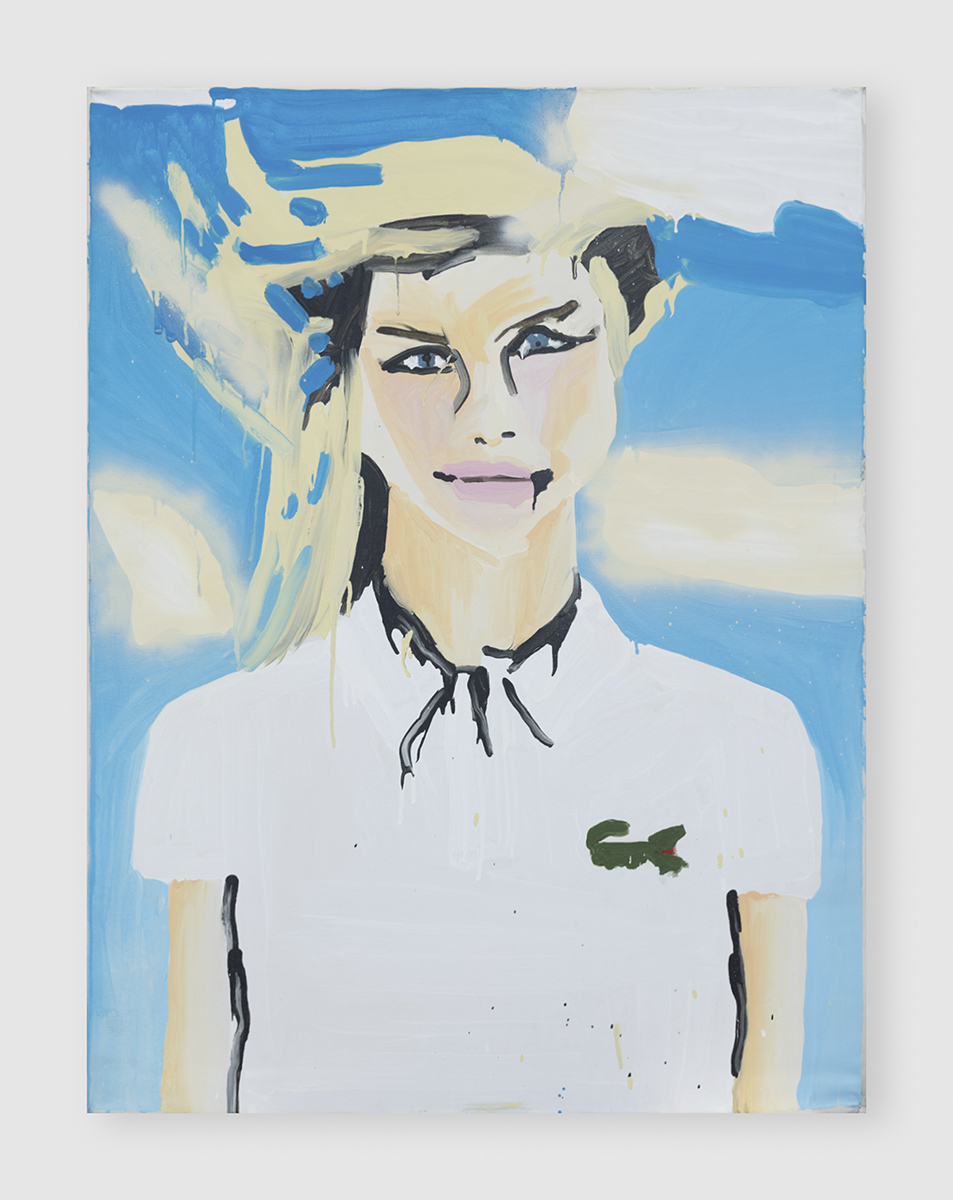
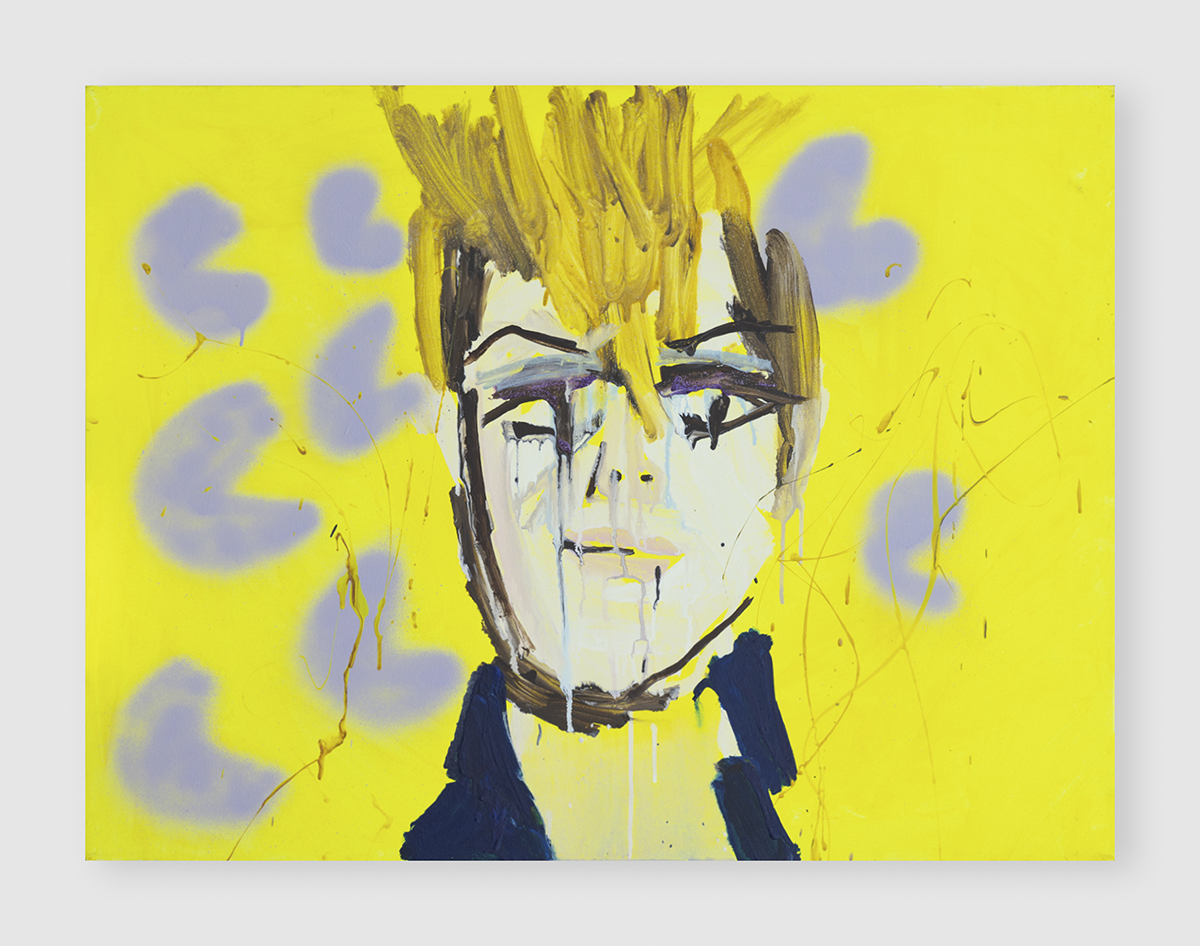
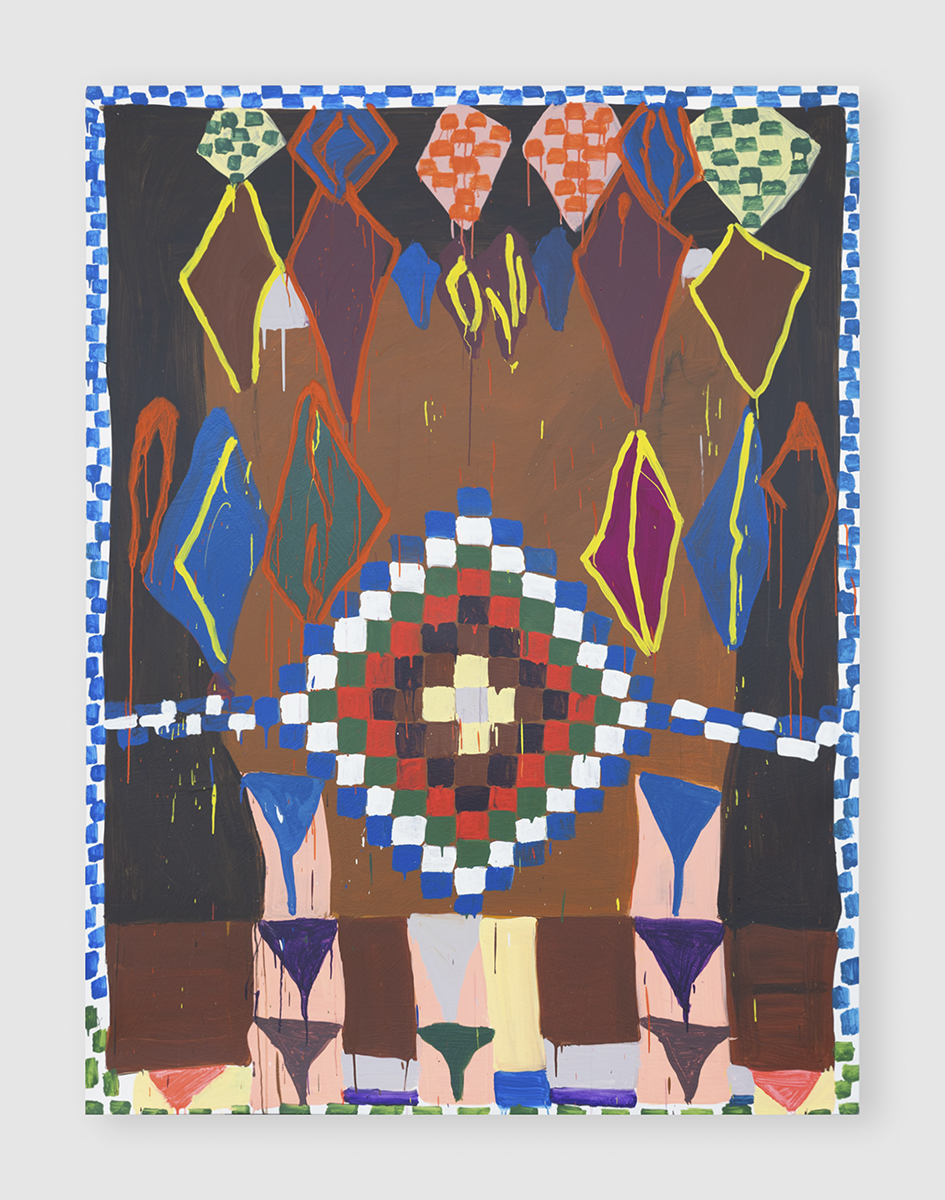
Katherine Bernhardt
April 2025
Katherine Bernhardt’s distinctive approach to painting is driven by an unfiltered visual curiosity and an explosive energy. Using bold strokes of spray paint and fluid acrylics, she crafts compositions that reject traditional illusion and perspective. Her canvases are vibrant collisions of pop culture references and everyday objects, creating a playful and unrestrained visual language that feels both immediate and dynamic.
Temple Magazine
First, what are your influences, whether visual, cultural, or personal, that feed your work at the moment? In your process, there is an immediacy, what drives this rhythm?
Katherine Bernhardt
First of all, everything from eucalyptus plants to Cookie Monster, ceramics, furniture design, swimming in nature, coffee, bananas. The new Lucky Charms came out, which is nice. Coffee, and then just different designs, popular culture, food—more specifically, Lucky Charms marshmallows, which I’ve been working on now, and Cookie Monster’s face, shoving food into Cookie Monster’s face, and butter.
Because I’m always trying to find something very obvious in everyday life that I’m overlooking. I started wondering, what am I not getting? Then I was like, oh, butter. I found this butter container and thought, wow, that’s amazing. So I’ve been making paintings like this.
Temple Magazine
You seem to focus on specific objects for a period of time, and then your focus evolves.
Katherine Bernhardt
For the show coming up in Los Angeles with David Zwirner, it's all about Cookie Monster, butter, and Lucky Charms.
Temple Magazine
What we can expect to see at that show in terms of themes?
Katherine Bernhardt
Large-scale work. Lots of Cookie Monsters, lots of butter, Lucky Charms, things like that.
Temple Magazine
Your technique is bold and fluid. Can you walk us through your process in the studio? Are there specific materials or techniques essential to transcribing this energy into your work?
Katherine Bernhardt
I make large-scale paintings, and those are the most fun to work on because they are active and physical. I use spray paint because it’s fast—I like to work fast. I start with an idea in my head but keep it spontaneous. I draw out the idea quickly, putting everything in there. I use spray paint as a drawing tool, and nothing is precious—I just go for it. Then I lay the painting flat and paint on that. It’s slightly slower but still fast. I water down the acrylic paint a lot, almost like watercolors. I like how the water moves around by itself, how it flows, and how it creates its own areas and colors.
Temple Magazine
Do you listen to very energetic music while working?
Katherine Bernhardt
Yeah. Reggaeton—Ozuna, Romeo Santos, Maluma, J Balvin, Bad Bunny.
Temple Magazine
You’re doing a retrospective show at the Hangaram Museum of Art at the Seoul Arts Center from June-September that will showcase around 100 works. How did you approach the selection process and the scenography? What was the biggest challenge in curating such a large-scale presentation of your work?
Katherine Bernhardt
Yes, it’s a huge show. I have a huge storage unit in Midtown, and I’ve always saved a lot of my work, from undergraduate and graduate school to now. We sourced almost everything from my archive. The biggest challenge was finding pieces in storage, realizing some weren’t even documented, and having to re-photograph everything—just the organization of it all. The show is chronological, starting with supermodels, then swatch watches, Moroccan rugs, a whole room about Puerto Rico, a room about cartoon figures, a pink room, and then new work. I think it’s going to be really good.
Temple Magazine
That sounds interesting because you focus on specific themes, so the chronological aspect will be nice.
Katherine Bernhardt
It’s about 10 or 12 rooms. They’re recreating my studio and even my bathrooms, which are all tiled. One room’s floor is a recreation of my studio floor. There are going to be lots of cool textures.
Temple Magazine
You also have an incredible collection of Memphis design. How is that an extension of your artistic universe? Does collecting these pieces connect with your painting practice?
Katherine Bernhardt
Yes, it’s all connected. As a kid, I loved Swatch watches, Esprit design, Benetton—everything 80s. I didn’t even know Ettore Sottsass, but he was designing for Esprit. I’ve always collected things—Swatch watches, Moroccan rugs, art. When I moved back to St. Louis, I bought a house from 1986 and thought, how do you furnish this? It had to be 80s, so Memphis Milano was a great idea. I got into collecting it. I visited the factory in Alba, Italy, and collaborated for Basel Miami last winter. They turned my designs into woven rugs. One looks like a painting, but it’s a rug.
Temple Magazine
That’s interesting how your patterns transpose into design, interior design, and fashion. You also collaborated with Heaven by Marc Jacobs. Is this something you want to explore more in the future?
Katherine Bernhardt
I like doing it because it’s something different. It brings in different crowds. The Memphis show in Miami attracted a lot of design people, which is a different world from the art world. The show with Jeremy Scott brought fashion people. The Heaven collaboration was great. I loved how he did the designs for that.
Temple Magazine
Just to get back to the exhibition with Jeremy Scott—how did this idea come up?
Katherine Bernhardt
I met Joanne Northrup, the curator at the Nerman Museum, through a friend, Carlos Rolon, who is also having a show there. She liked my work and was thinking about a project. Since they’re in Kansas City, they wanted to involve someone from there. Jeremy Scott is the biggest name from that area. So she suggested a show with me and Jeremy. We had a mutual friend who connected us. It was crazy because I didn’t know his work that well. I had the Moschino perfume that looks like Windex and a t-shirt from when I was younger, but that was it. When Joanne told me about the show, I got a book on Jeremy Scott and realized I had been painting things he had been making clothing out of. It felt like a parallel universe. The show is up until August. We hung my paintings first, and then Jeremy spent a month curating his pieces around them. It turned out awesome—there’s so much to see. You really have to go back more than once.
Temple Magazine
It’s crazy that the idea wasn’t from you or Jeremy, yet it’s a perfect match.
Katherine Bernhardt
I hope the show travels.
Temple Magazine
Your work is instantly recognizable. How did this visual language evolve over time? Were there pivotal moments that shaped your approach?
Katherine Bernhardt
In art school, there was no structure—it was very open. In undergrad, I was painting objects—vacuum sweepers, nail clippers, chairs, shoes. Then I painted ETs. After moving to New York, I painted supermodels. Then I started making pattern paintings, which brought objects back into the work in a structured way. Later, I reintroduced figures like The Pink Panther and Garfield into these patterns. My work is always evolving—I’m not trying to create a style, it just happens. But I guess that’s what you want, for it to be recognizable. That’s just what it is.
CREDITS
Katherine Bernhardt, Chew, 2024
© Katherine Bernhardt
Courtesy the artist, David Zwirner, and Canada
Katherine Bernhardt, It's Butter!, 2024
© Katherine Bernhardt. Courtesy the artist, David Zwirner, and Canada
Katherine Bernhardt, Butter Butter Butter Butter Butter, 2024
© Katherine Bernhardt. Courtesy the artist, David Zwirner, and Canada
Katherine Bernhardt, Needles, 2009
© Katherine Bernhardt. Courtesy the artist and David Zwirner
Katherine Bernhardt, Izod, 2001
© Katherine Bernhardt. Courtesy the artist and David Zwirner
Installation view, Katherine Bernhardt and Jeremy Scott: A Match Made in Heaven, Nerman
Museum of Contemporary Art, Overland Park, Kansas, 2024. Photo by Jacob Banholzer
Installation view, Memphis Miami, presented by Capsule and Basic.Space, 2024
© Capsule x Basic.Space
Katherine Bernhardt, Packman, 2001
© Katherine Bernhardt. Courtesy the artist and David Zwirner
Katherine Bernhardt, Sabah el Kheir, 2010
© Katherine Bernhardt. Courtesy the artist and David Zwirner
Katherine Bernhardt, Untitled, 2015
© Katherine Bernhardt. Courtesy the artist and David Zwirner
Temple Magazine
First, I wanted to start the interview by asking you what are your influences, whether visual, cultural, or personal, that feed your work at the moment? Because I read that in your process, there is an immediacy, and I was wondering what drives this rhythm.
Katherine Bernhardt
First of all, everything from eucalyptus plants to Cookie Monster, ceramics, furniture design, swimming in nature, coffee, bananas. The new Lucky Charms came out, which is nice. Coffee, and then just different designs, popular culture, food—more specifically, Lucky Charms marshmallows, which I’ve been working on now, and Cookie Monster’s face, shoving food into Cookie Monster’s face, and butter.
Temple Magazine
Butter. Okay.
Katherine Bernhardt
Yes, butter. Because I’m always trying to find something very obvious in everyday life that I’m overlooking. I started wondering, what am I not getting? Then I was like, oh, butter. I found this butter container and thought, wow, that’s amazing. So I’ve been making paintings like this.
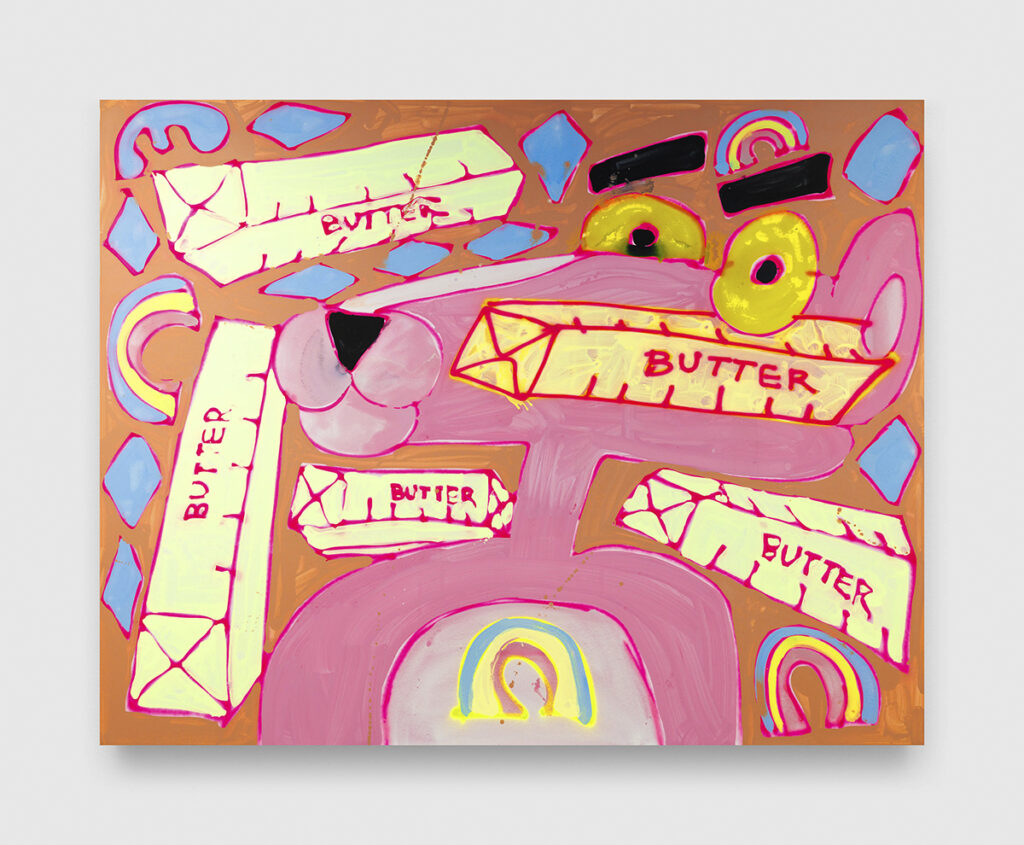
Temple Magazine
You seem to focus on specific objects for a period of time, and then your focus evolves.
Katherine Bernhardt
For the show coming up in Los Angeles, it's all about Cookie Monster, butter, and Lucky Charms.
Temple Magazine
With David Zwirner, right?
Katherine Bernhardt
Yeah.
Temple Magazine
I was wondering what we can expect to see at that show in terms of themes.
Katherine Bernhardt
Large-scale work. Lots of Cookie Monsters, lots of butter, Lucky Charms, things like that.
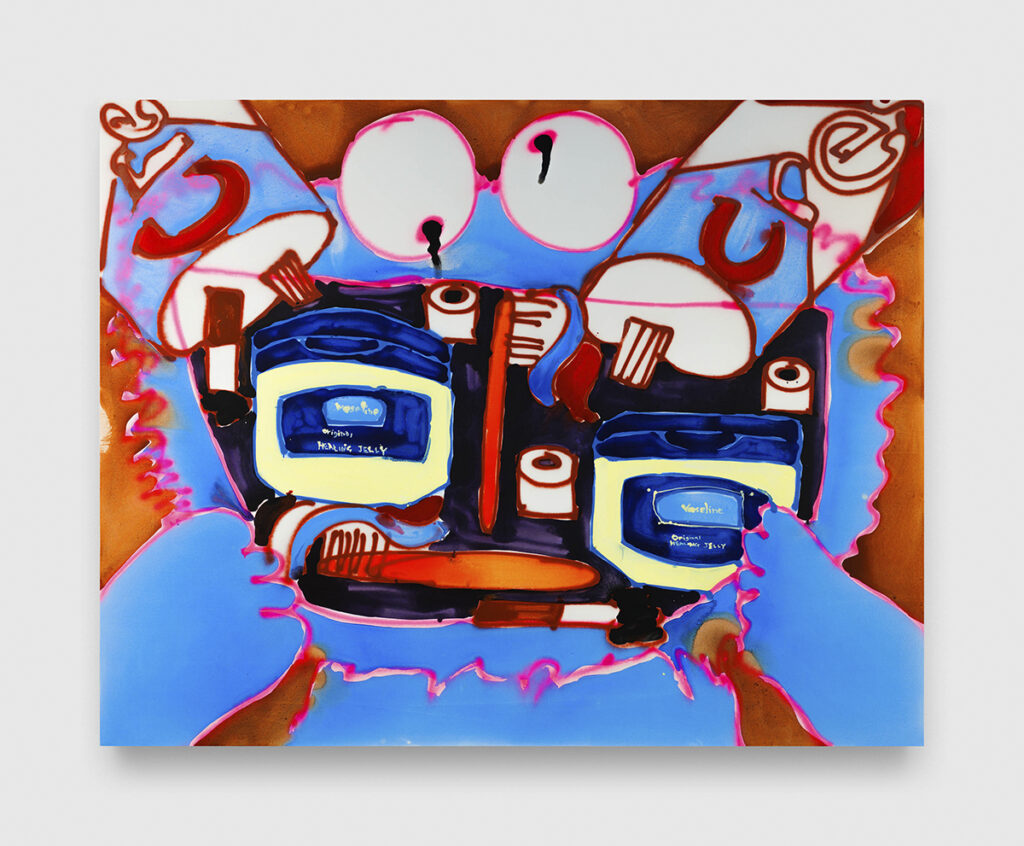
Temple Magazine
Your technique is bold and fluid. Can you walk us through your process in the studio? Are there specific materials or techniques essential to transcribing this energy into your work?
Katherine Bernhardt
I make large-scale paintings, and those are the most fun to work on because they are active and physical. I use spray paint because it’s fast—I like to work fast. I start with an idea in my head but keep it spontaneous. I draw out the idea quickly, putting everything in there. I use spray paint as a drawing tool, and nothing is precious—I just go for it. Then I lay the painting flat and paint on that. It’s slightly slower but still fast. I water down the acrylic paint a lot, almost like watercolors. I like how the water moves around by itself, how it flows, and how it creates its own areas and colors.
Temple Magazine
Do you listen to very energetic music while working?
Katherine Bernhardt
Yeah. Reggaeton—Ozuna, Romeo Santos, Maluma, J Balvin, Bad Bunny.
Temple Magazine
Your gallerists told me you’re doing a retrospective show at the Hangaram Museum of Art at the Seoul Arts Center from June-September that will showcase around 100 works. That’s huge. How did you approach the selection process and the scenography? What was the biggest challenge in curating such a large-scale presentation of your work?
Katherine Bernhardt
Yes, it’s a huge show. I have a huge storage unit in Midtown, and I’ve always saved a lot of my work, from undergraduate and graduate school to now. We sourced almost everything from my archive. The biggest challenge was finding pieces in storage, realizing some weren’t even documented, and having to re-photograph everything—just the organization of it all. The show is chronological, starting with supermodels, then swatch watches, Moroccan rugs, a whole room about Puerto Rico, a room about cartoon figures, a pink room, and then new work. I think it’s going to be really good.
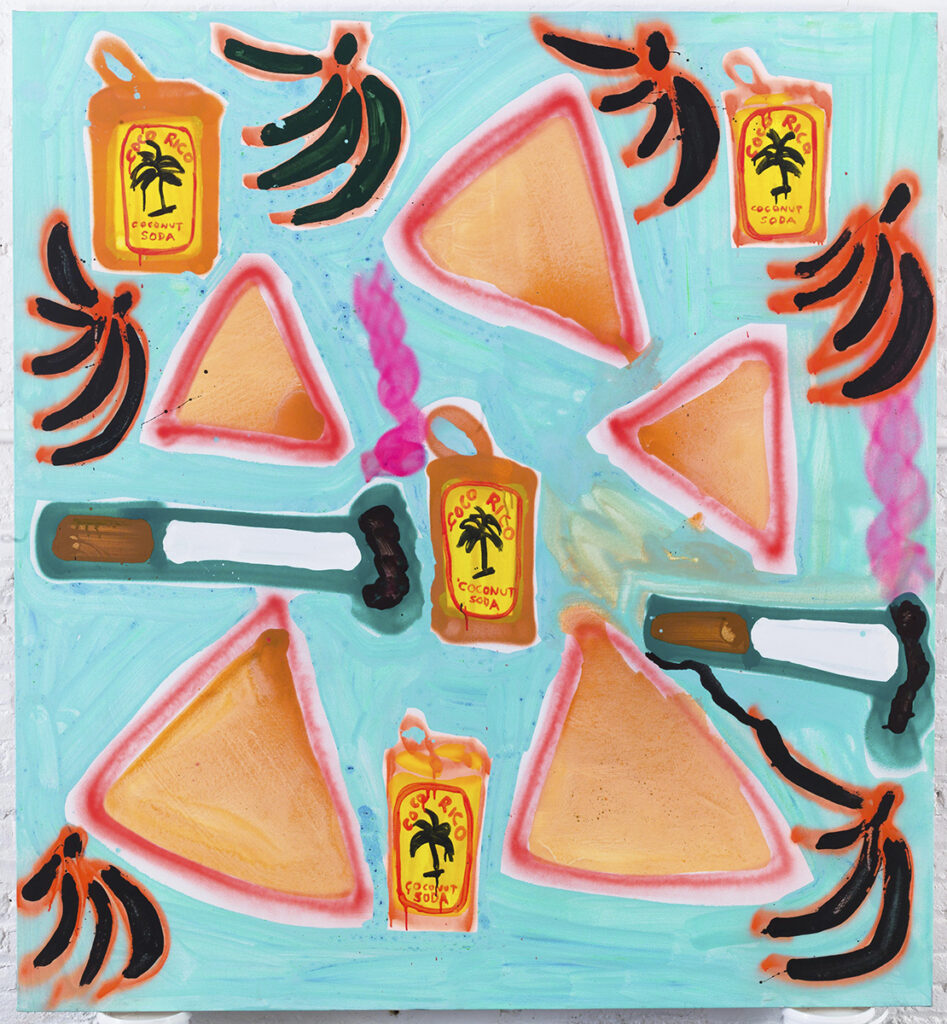
Temple Magazine
That sounds interesting because you focus on specific themes, so the chronological aspect will be nice.
Katherine Bernhardt
It’s about 10 or 12 rooms. They’re recreating my studio and even my bathrooms, which are all tiled. One room’s floor is a recreation of my studio floor. There are going to be lots of cool textures.
Temple Magazine
I know you have an incredible collection of Memphis design. How is that an extension of your artistic universe? Does collecting these pieces connect with your painting practice?
Katherine Bernhardt
Yes, it’s all connected. As a kid, I loved Swatch watches, Esprit design, Benetton—everything 80s. I didn’t even know Ettore Sottsass, but he was designing for Esprit. I’ve always collected things—Swatch watches, Moroccan rugs, art. When I moved back to St. Louis, I bought a house from 1986 and thought, how do you furnish this? It had to be 80s, so Memphis Milano was a great idea. I got into collecting it. I visited the factory in Alba, Italy, and collaborated for Basel Miami last winter. They turned my designs into woven rugs. One looks like a painting, but it’s a rug.
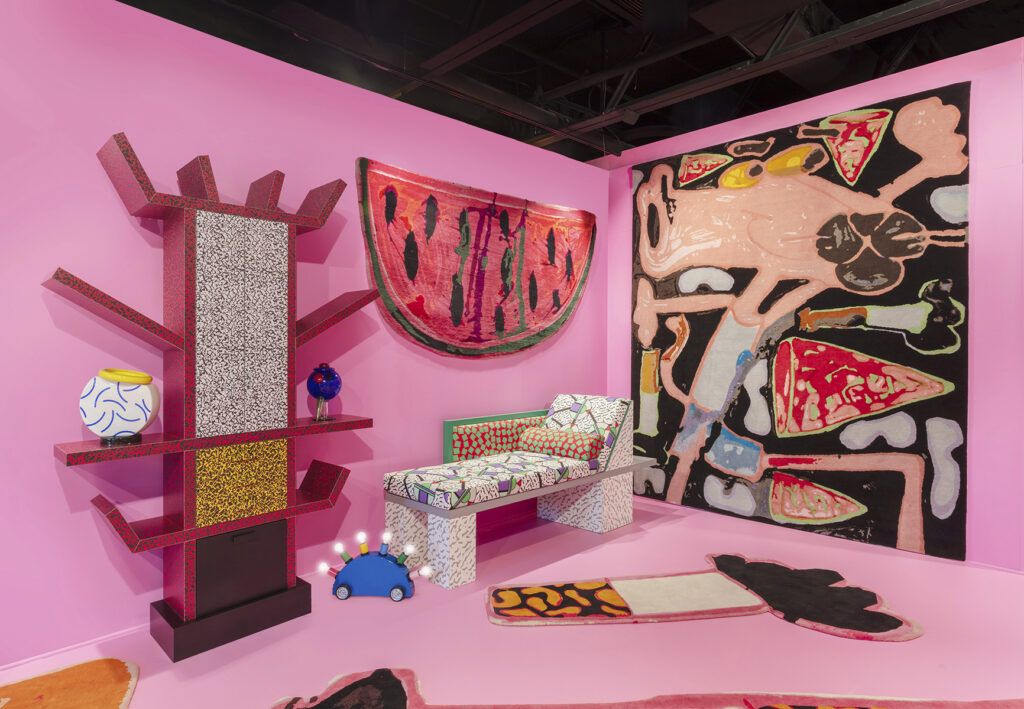
Temple Magazine
That’s interesting how your patterns transpose into design, interior design, and fashion. You also collaborated with Heaven by Marc Jacobs. Is this something you want to explore more in the future?
Katherine Bernhardt
Yeah, I like doing it because it’s something different. It brings in different crowds. The Memphis show in Miami attracted a lot of design people, which is a different world from the art world. The show with Jeremy Scott brought fashion people. The Heaven collaboration was great. I loved how he did the designs for that.

Temple Magazine
Just to get back to the exhibition with Jeremy Scott—how did this idea come up?
Katherine Bernhardt
I met Joanne Northrup, the curator at the Nerman Museum, through a friend, Carlos Rolon, who is also having a show there. She liked my work and was thinking about a project. Since they’re in Kansas City, they wanted to involve someone from there. Jeremy Scott is the biggest name from that area. So she suggested a show with me and Jeremy. We had a mutual friend who connected us. It was crazy because I didn’t know his work that well. I had the Moschino perfume that looks like Windex and a t-shirt from when I was younger, but that was it. When Joanne told me about the show, I got a book on Jeremy Scott and realized I had been painting things he had been making clothing out of. It felt like a parallel universe. The show is up until August. We hung my paintings first, and then Jeremy spent a month curating his pieces around them. It turned out awesome—there’s so much to see. You really have to go back more than once.
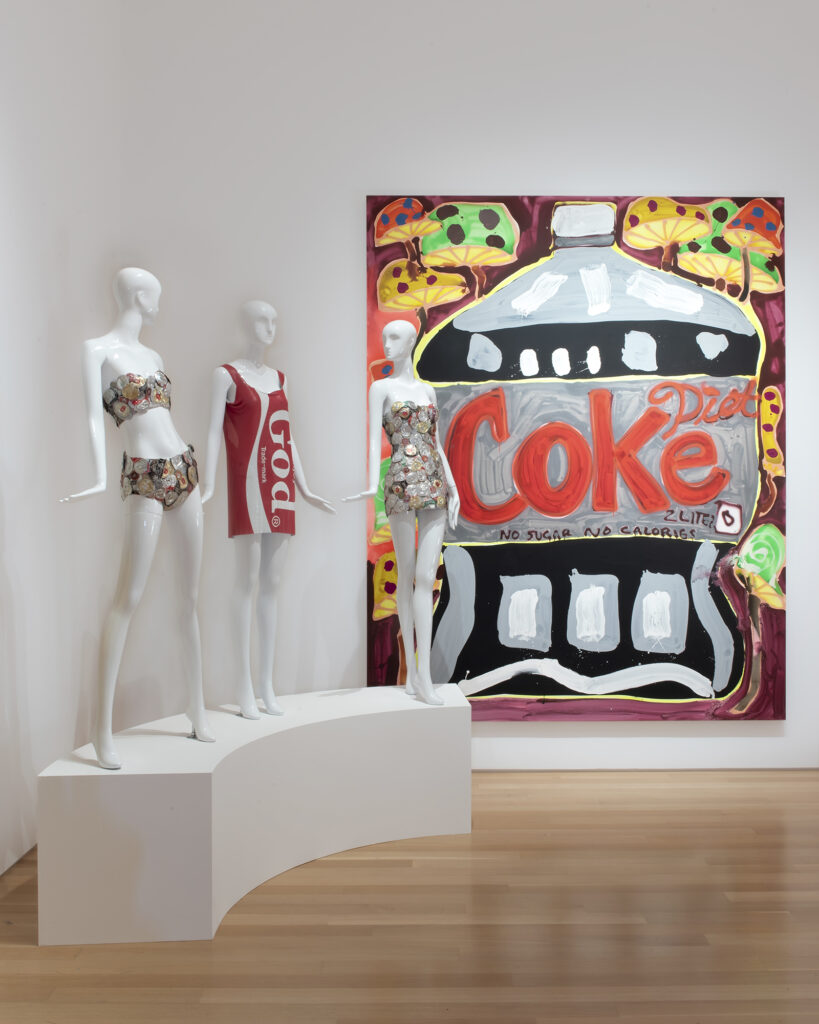
Temple Magazine
It’s crazy that the idea wasn’t from you or Jeremy, yet it’s a perfect match.
Katherine Bernhardt
Yeah, I hope the show travels.
Temple Magazine
That would be great.
Your work is instantly recognizable. How did this visual language evolve over time? Were there pivotal moments that shaped your approach?
Katherine Bernhardt
In art school, there was no structure—it was very open. In undergrad, I was painting objects—vacuum sweepers, nail clippers, chairs, shoes. Then I painted ETs. After moving to New York, I painted supermodels. Then I started making pattern paintings, which brought objects back into the work in a structured way. Later, I reintroduced figures like The Pink Panther and Garfield into these patterns. My work is always evolving—I’m not trying to create a style, it just happens. But I guess that’s what you want, for it to be recognizable. That’s just what it is.
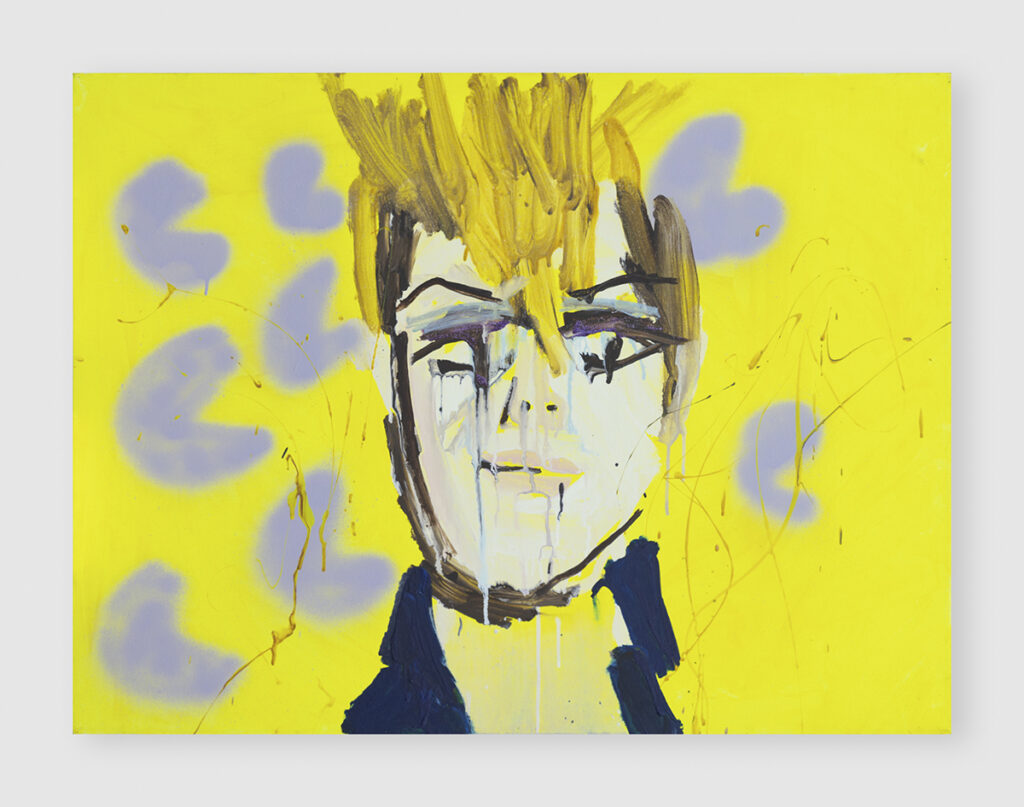
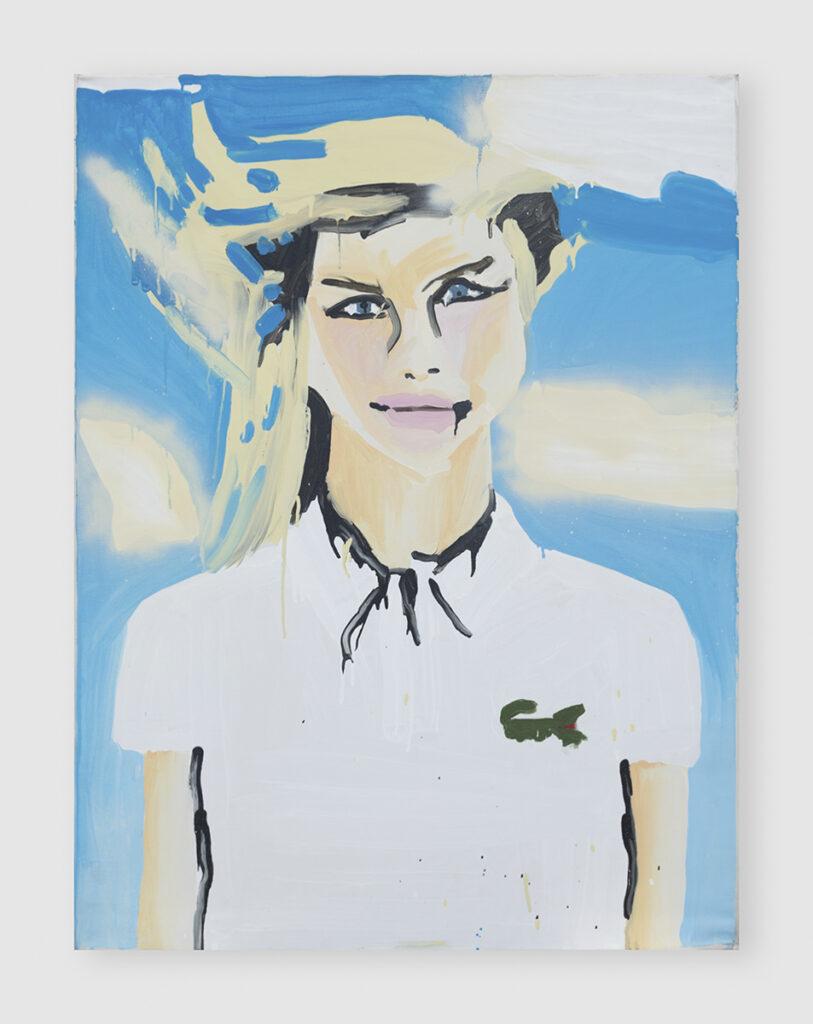
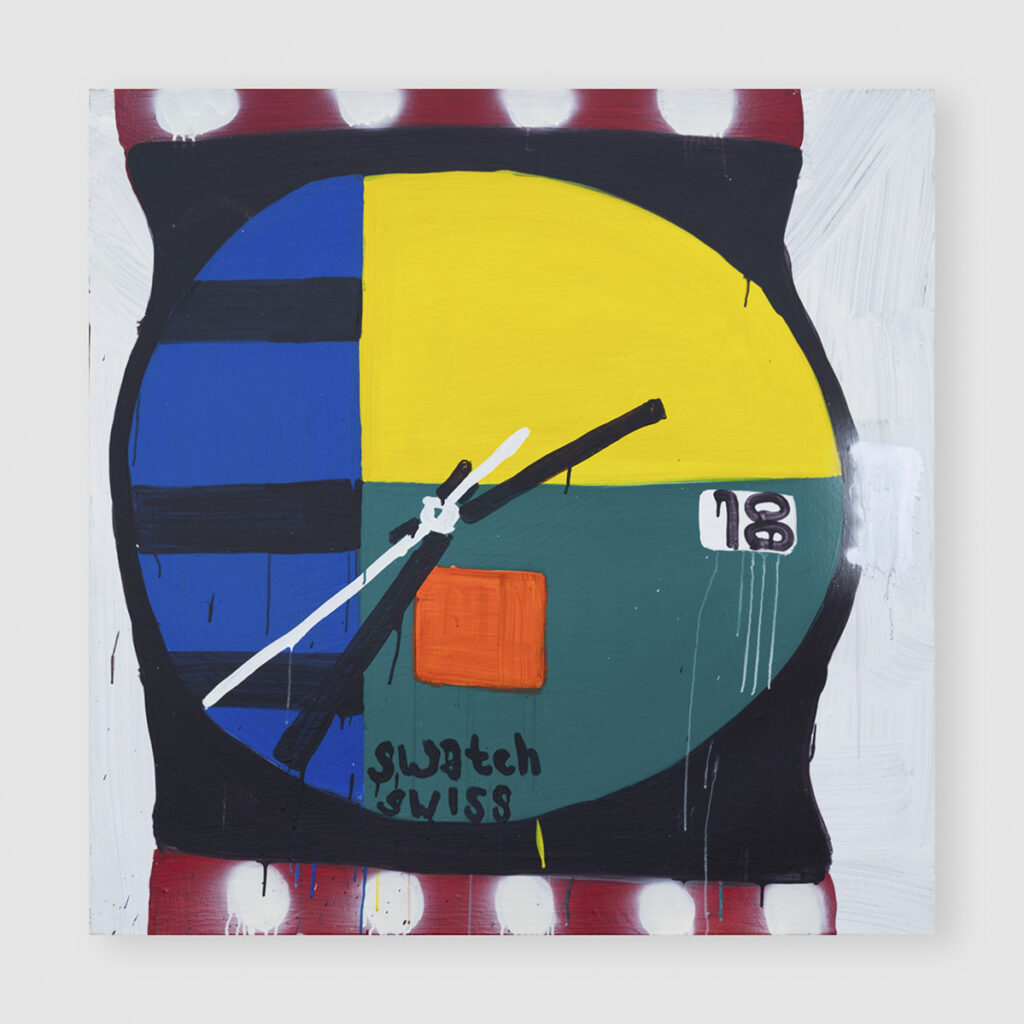
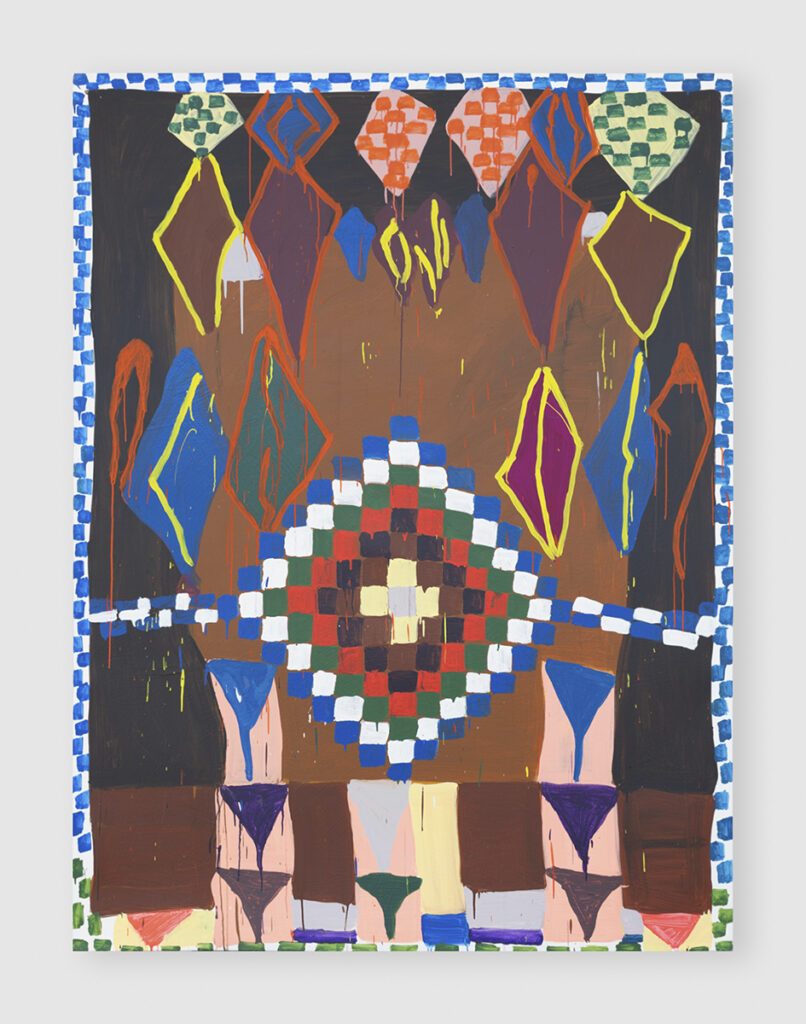
Images credits
Katherine Bernhardt, Chew, 2024
© Katherine Bernhardt
Courtesy the artist, David Zwirner, and Canada
Katherine Bernhardt, It's Butter!, 2024
© Katherine Bernhardt. Courtesy the artist, David Zwirner, and Canada
Katherine Bernhardt, Butter Butter Butter Butter Butter, 2024
© Katherine Bernhardt. Courtesy the artist, David Zwirner, and Canada
Katherine Bernhardt, Needles, 2009
© Katherine Bernhardt. Courtesy the artist and David Zwirner
Katherine Bernhardt, Izod, 2001
© Katherine Bernhardt. Courtesy the artist and David Zwirner
Installation view, Katherine Bernhardt and Jeremy Scott: A Match Made in Heaven, Nerman
Museum of Contemporary Art, Overland Park, Kansas, 2024. Photo by Jacob Banholzer
Installation view, Memphis Miami, presented by Capsule and Basic.Space, 2024
© Capsule x Basic.Space
Katherine Bernhardt, Packman, 2001
© Katherine Bernhardt. Courtesy the artist and David Zwirner
Katherine Bernhardt, Sabah el Kheir, 2010
© Katherine Bernhardt. Courtesy the artist and David Zwirner
Katherine Bernhardt, Untitled, 2015
© Katherine Bernhardt. Courtesy the artist and David Zwirner
